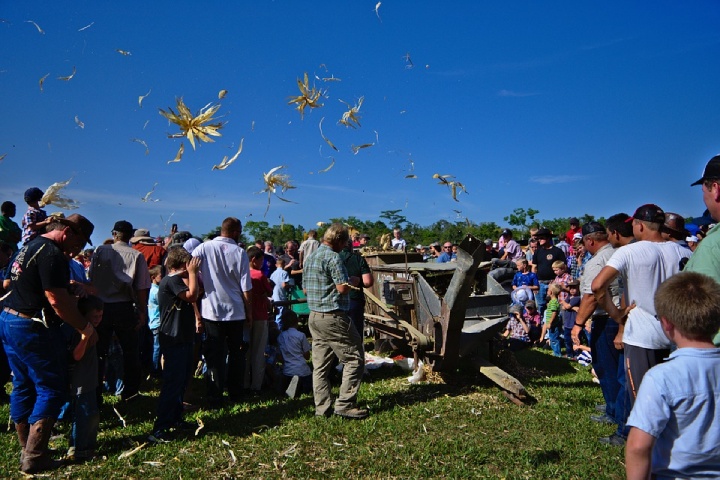
What is your earliest memory?
Here’s mine. I stood in the dining room of my grandparents’ house holding a tall glass of milk when it slipped out of my fingers. Milk splattered all over the floor. Fear took hold of me as I looked to my grandfather, who had been sitting there at the table. I knew he was going to be mad at me. But he wasn’t. He just smiled and told me not to worry. “Muffin and Angel will clean it up.”
Sure enough, their two dogs soon appeared, happy to enjoy the fruits of my folly. And all was well in the world once again.
I had to have been three years old or younger because that’s when my grandfather passed away. I don’t know why I remember this. I honestly don’t even know if it really happened. But I remember it.
I can picture so clearly the room where it happened. I can see my grandfather’s smiling face. I remember the texture of the plastic cup. I even think it was green.
Then again, that happened in the same house where my grandmother lives to this day, a house I grew up visiting daily, so of course, I know what the room looked like. I’ve also seen many pictures of my grandfather throughout the years. There is one sitting in my office. And now that I think about it, I’m pretty sure that green, plastic cup is still in my grandmother’s cabinets.
And yet, the layout of the dining room looks different in my memory than it does today. And I can’t explain how I remember what my grandfather’s voice sounded like.
Memories are weird.
Defining Remembrance
I think of memory like one of J. K. Rowling’s boggarts. It’s filed away deep inside our psyche, unknowable and mysterious. We never really see the true form of our memories, but only the ways in which they reveal themselves to us. Our memory is revealed through the act of remembering. So instead of attempting a definition of the noun, this is my shot at the verb.
To remember is to create imaginative representations of events previously recorded for particular purposes.
Creative and Imaginative
In my previous post, I argued that it is the human imagination that enables us to create sensory images and experiences in our minds. And this is exactly what happens when we remember a memory. We don’t just see a picture or read a summary. We relive the experience.
The problem is we don’t remember in full HD. Memories tend to be blurs of detail. A sound or a smell here, a face there. Rarely, if ever, do we remember conversations in exact words, but in concepts and paraphrases. Most of the time, our minds fill in the blanks of our memories, adding details where there are none in order to create a more believable and livable experience.
Representations of Events
Even though the act of remembering is a creative and imaginative endeavor, it does not mean that the memories we remember are not true. Our memories do not have to be completely accurate in order to be considered truthful, because memories are only representations of events that happen in our lives.
I think this is a difficult concept for our culture to grasp. In a world full of verbatim transcription and copy machines, we value exactness and accuracy. But memories are not photocopies of events, nor should we treat them as such.
When we remember, we do not remember every detail, but only those things that our brains have decided are important and worthy of remembrance. This leads us to the final part of this definition…
For Particular Purposes
At least I imagine our brains must have particular purposes for stowing away our memories. I remember spilling milk at my grandfather’s feet, but I don’t remember grieving his death which must have taken place shortly thereafter.
I don’t know what particular purposes our brains have in mind for storing some memories and not others. But I do think it’s clear that there is a particular and purposeful ordering of our memories.
Memories likely serve many purposes, but my purpose here is not to be comprehensive. Ultimately, I don’t think we remember things solely for the sake of keeping a record of all of our experiences. Otherwise, we would remember more and we would remember more clearly. Instead, I think memory is much more about creating an identity for ourselves.
Our memories are representations of true events. Even though they may not be entirely accurate representations, they are still true in that they reflect historical facts. But memories are even truer in that they reflect a deeper sense of our reality, of what it means to be us. They continually shape us by influencing our perception of the world and informing our future decisions.
Memories tell us who we are, where we’ve been, and where we’re going.
Communal Memories
When I was in my high school marching band, we used to dance in the band stands at football games when the drum-line played their cadences. We had several different dances, and most of them were school-appropriate. But everyone’s favorite was the Stymie.
Before high school and before I even knew about the Stymie, my mom told me about my uncle’s experience in that same marching band years before. Stymie, she told me, is what his band director nicknamed him, after the character from Little Rascals. She also told me that my uncle invented a dance to the drum-line cadences that they called the Stymie Shuffle.
The name changed a bit. The dance changed a lot, if not completely. But the memory of my Uncle Stymie still lived on in the form of dance.
This is a simplified illustration of a phenomenon that happens in every community that has ever existed, from high school marching bands to small towns, to entire cultures and religions. Memory is not something that happens only within the individual, but it also takes place on a corporate scale.
Community memories take the form of traditions. And like personal memories, these traditions cannot easily be identified on their own, apart from the ways in which they are revealed. The Stymie dance itself is not a tradition, but it is only the medium through which the tradition was preserved. At the same time, the tradition represented by and preserved through the Stymie cannot really be distinguished from the dance. The tradition and the medium are separate, but they are one.
So dance is one way in which tradition can be preserved and transmitted. Other media include art, story, legend, song, film, history book, novel, legal documents. The possibilities are nearly limitless.
Also, like personal memories, these community traditions develop a sense of identity. When a group of people can come together around a tradition, they are not only adopting a corporate memory, but also a corporate ideology. They begin to identify with one another in a unique way and to see themselves not as individuals, but as a unity.

As a body. Do you see where I’m going with this?
The Bible is a collection of memories. The collective memory of Israel, the people of God, and the followers of Christ. As we are a part of the same community that developed, preserved, and revered the biblical traditions, the Bible is a huge part of our corporate memory.
Granted, a lot has happened in the years since the writing of scripture, and the corporate memory of the Body of Christ has expanded beyond the traditions in the Bible. Yet the biblical memory continues to be the foundation and the measure by which other memories enter the imagination of the church.
Like memory, the literary traditions in the Bible record events and experiences that actually happened in real history for the purpose of instructing God’s people, reminding them of the past, and giving them hope for the future.
But also like memories, the biblical literature does not contain fully detailed accounts of what happened in Israel’s history. Some details are fuzzy. Some are left out. Some may be added to fill in the blanks.
And this doesn’t mean the Bible is not true. Remember, we can’t expect memory to be anything other than a creative representation of an event; the same goes for the Bible.
As literature, the Bible is by default a creative representation of something. Some literary works are representations of something created in the mind. This we call fiction. The Bible’s referent, however, is in historical events. The biblical traditions are not the events to which they refer, yet at the same time cannot be distinguished from these events.
The Bible is a library full of many different works of literature, each individual piece coming together to form a coherent symphony, to tell a single story. Our story. But more importantly, God’s story.
As the collective memory of God’s people, and of humanity as a whole, the biblical traditions form our identity. They tell us who we are, where we’ve been,, and where we’re going. They tell us our purpose, our goal, our mission. But more than this, the biblical traditions turn our focus to God. Our collective memory reminds us that the Bible is not about us, this life is not about us, but about giving glory, honor, and praise to our God, the only one who is worthy of all of it.
